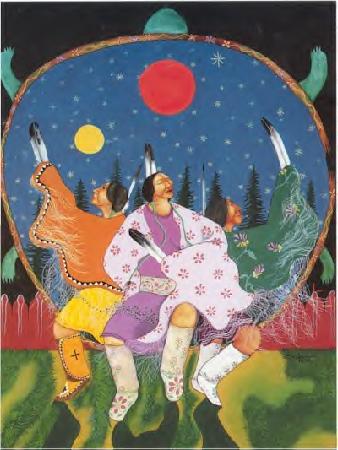
Canku Ota

(Many Paths)
An Online Newsletter Celebrating Native America
February 22, 2003 - Issue 81
![]()
'Unity' Serves All Journalists of Color
by Dorreen Yellow Bird Grand Forks Herald
credits: Women Are Sacred by Sam English
|
|
Canku Ota |
|
|
(Many Paths) |
||
|
An Online Newsletter Celebrating Native America |
||
|
February 22, 2003 - Issue 81 |
||
|
|
||
|
'Unity' Serves All Journalists of Color |
||
|
by Dorreen Yellow Bird Grand Forks Herald |
||
|
credits: Women Are Sacred by Sam English |
 When
the West opened up to settlers, many tribes were pushed almost to extinction. When
the West opened up to settlers, many tribes were pushed almost to extinction.
There are those who say the tribes would have fared much better if they had united - the Sahnish, Dakota, Hidatsa, Mandan, Cheyenne, Chippewa, Lakota and others - and formed one force against encroaching non-Natives. Perhaps we would have held the spread east of the Mississippi, they say. Most tribes held to their own nations, their own prejudices and even fought against each other. I think about those historic events when I attend the meetings of the board of directors of Unity, Journalists of Color Inc. I am a board member of the organization. We are four very different cultures and populations: Asian American Journalistic Association (AAJA); National Association of Black Journalists (NABJ); National Association of Hispanic Journalists (NAHJ) and the Native American Journalists Association (NAJA). We come together to plan and organize a conference around common issues every five years. We are planning our third convention for Washington D.C. in 2004. Some of the basic beliefs of Unity are that we can help journalists of color have clearer and louder voices in the mainstream media. We can advocate, educate, watch for fairness and accuracy in the media and diversify American newsrooms. Journalists of color believe words matter and being racially conscious matters. This is not to say every reporter should cover race-related stories the same way. We need to be aware that as we shape public discourse, the media has an affect on society's perceptions of race. The media sometime determines how racial experiences cause people of color to view society from a different frame of reference. And we need to be aware of the impact of media-reinforced negative stereotypes throughout history. Recent studies show 40 percent of mainstream newspapers have no nonwhites on staff. Nonwhites make-up a total of 11.5 percent of newspaper staffs and 20 percent of the television news industry. In most newsrooms, people of color make up a smaller percentage than they do in the nation's population at large, where they total 26 percent. These are some of our common goals, but there are times when it has been difficult to find common ground among four very different cultures on simple planning issues. A black woman on the board reminded me of that when I arrived in Fort Worth for the recent meeting. She observed that, as board members, it is difficult to remember that we represent Unity, not our own group. For Unity, it was a natural evolution from the yearly conferences held by each of the four groups. We realized that we had many of the same problems, our issues overlapped and we inevitably found ourselves at the same table discussing these same issues. So, a coalition of journalists of color was formed in 1994 for the first-ever conference in Atlanta. More than 3,800 people attended the conference, where programs such as the Town Hall meetings began. The Job Fair resulted in 3,700 journalists being interviewed, and 288 were hired. Unity also has developed several programs around career building, professional development and networking. One of the most successful is the mentor program meant to increase newsroom diversity and cross-cultural understanding. It matches fledging reporters with seasoned journalists. I attended the second Unity conference is Seattle in 1999, where numbers were almost double that in Atlanta. The 2004 conference in Washington promises to be even larger. NAJA is the smallest of the four groups. We are rural, and many of our media are from reservations with little travel money. But our numbers are growing, as is our involvement in the mainstream media and in Unity. |
|
|
||
|
|
||
| Canku Ota is a free Newsletter celebrating Native America, its traditions and accomplishments . We do not provide subscriber or visitor names to anyone. Some articles presented in Canku Ota may contain copyright material. We have received appropriate permissions for republishing any articles. Material appearing here is distributed without profit or monetary gain to those who have expressed an interest. This is in accordance with Title 17 U.S.C. section 107. | ||
|
Canku Ota is a copyright © 2000, 2001, 2002, 2003 of Vicki Lockard and Paul Barry. |
||
 |
 |
|
|
The "Canku Ota - A Newsletter Celebrating Native America" web site and its design is the |
||
|
Copyright © 1999, 2000, 2001, 2002, 2003 of Paul C. Barry. |
||
|
All Rights Reserved. |
||
Thank You